
[home]
[Programs]
[Gallery]
[News]
|
The Chicago Public Art Group
Local Color
The University of Chicago Magazine June 1996
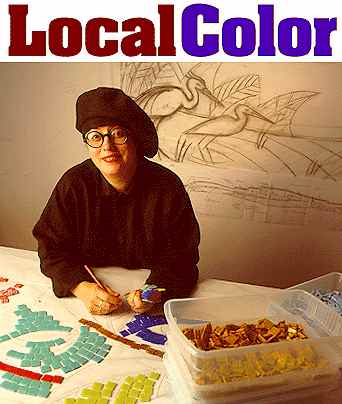
Brightening Chicago's streets and schools, the murals and mosaics of
Olivia Gude and friends address social divisions--and unite communities.
By Kimberly Sweet
Photography by Matthew Gilson
When Olivia Gude read about the racial tension-manifested in fights
and graffiti-brewing at Chicago's Charles Steinmetz High School in spring
1993, she got more than a little upset. She didn't form a committee to
discuss the problems, and she didn't write a letter to protest them, but she
definitely couldn't ignore them. What that school needed, thought Gude,
MFA'82, was a mosaic.
So she approached the principal with her portfolio and her idea: to have
Steinmetz students work together under her supervision to design and create
a multiracially themed piece for the school. The principal gave Gude the
go-ahead, and after two years, with the help of more than 100 students,
Steinmetz High's foyer had 18 sections of mosaic covering over 200 square
feet. And at five hours of work per one square foot of mural, the students
had plenty of time to talk over their differences.
A community muralist and 13-year member of Chicago Public Art Group (CPAG),
Gude sees art not only as a way to beautify the world but also as an agent
of social change, a means to reclaim public space and bring people together.
Fifty or so pieces that Gude has worked on are scattered throughout
Chicago-area streets and schools. If you've been in Hyde Park sometime this
decade, you've probably seen either the mural on the 56th Street Metra
underpass, featuring strikingly real portraits of commuters and their
musings on life, or the brightly hued nature scenes gracing the game room at
International House. Other works adorn a freeway wall in Los Angeles and a
bus in Russia. Her painted murals and tiled mosaics-created in collaboration
with other CPAG artists and community members-address themes of race, class,
gender, place, and justice. For Gude (pronounced "goody"), it's about
fostering "communities of discourse"-physical and intellectual spaces in
which to discuss divisive issues and perhaps close some gaps.
"What's so interesting"-many of her sentences begin this way-"is the way
these murals work. It's the interaction that happens that makes the piece.
What does it mean to have black people and white people sit down and talk
about issues of community?" asks Gude, putting the question on the table
with a quick motion of her hands-three rings on the left one, two rings on
the right. "For communities to function, they have to be constantly kept up.
There has to be this kind of constant interaction."
After majoring in art at Webster College (now University), she began her
career in 1973 as a St. Louis high-school art instructor, viewing teaching
as "a liberating activity that could change people's perceptions." Two years
later, Gude moved to Chicago and started teaching at Bloom Trail High School
in Chicago Heights. There, students changed her own perceptions, as their
interest in painting impelled her to start working in that medium. Most of
her prior art-influenced by the women's movement-had involved patterns,
fabric, sewing, and assemblage. At Bloom Trail, she also painted her first
public pieces: In an effort to keep spring fever at bay, she and fellow art
teacher Jon Pounds-her husband since 1986 and the current head of
CPAG-enlisted their students in end-of-the-school-year mural projects.
But it was when she took two years out to attend the U of C and concentrate
on her own work, explains Gude, intense behind round, black-framed glasses,
that she "really recognized that art, far from being this preserve that was
separate from life, was intrinsically part of all of these issues about
culture, about human possibility, about justice." Coming from a large,
working-class family in St. Louis, she strongly felt that art, even "of the
highest complexity," didn't have to address an elite audience or exist only
in museums and galleries. Gude, along with Pounds, acted on that belief by
doing street pieces-without permission, but using temporary materials such
as chalk-around their South Side neighborhood of Pullman. The works soon
caught the attention of CPAG, known then as Chicago Mural Group.
The group gave Gude a "second graduate education," this one in the
techniques and philosophy of the community mural tradition, while she taught
part time at Bloom Trail, held residencies in other schools, and lectured at
area art schools and universities, including the U of C. Rooted in the late
1960s, the contemporary mural movement, of which CPAG is a part, emphasizes
a mentoring style of training and the idea of a multicultural America.
CPAG's 30-plus members, some of whom Gude has herself helped to train, span
a range of races and nationalities. The members often collaborate, and Gude
in particular ascribes to the method: She is usually one of two or three
lead artists assisted by a number of volunteers. Gude speaks of the concept
of the collective as "a terrifically important image" in present-day
America, "a society of hyperindividuals."
"It's completely different from a Nietz-schean view that what you really
want is one or two supermen or superwomen who can envision this amazing
possibility," says Gude. She believes that collaborations create works
greater than any one person could make while still allowing for each
artist's individual vision.
Some projects begin with the artistic team suggesting a mural to a
community, then talking to residents and local leaders to drum up support
and volunteers. Both are usually in generous supply, in part because CPAG
makes sure the artistic teams represent each community's racial makeup.
Other times a community approaches a particular artist or CPAG for
assistance. Neighborhood groups and schools cosponsor projects through
fund-raising; CPAG may provide seed money or matching funds and also obtains
the necessary permits.
Community volunteers join artists in group brainstorming sessions and
drawing exercises, with those people who have art experience helping to
realize the others' images. After decisions on what to include are reached
by consensus-not majority rule-the sketches are developed, copied, cut, and
pasted into a collage that serves as a model for the final drawing. Once the
mural's outline has been traced on the wall, still more volunteers and youth
assistants join in the painting.
In the past few years, Gude has delved into variations on the traditionally
painted mural, including mosaics and spray-painted art. Usually placed in
doorways and arches, "mosaics are a way of engaging people as they enter a
space," she said in a CPAG newsletter. "There's a pure physicality of the
materials and a decorativeness to them that's unbelievable, like patchwork
quilts." The time-intensive creation of a mosaic involves laying colored
ceramic or glass tiles onto a full-scale drawing of the mural. Contact paper
holds the tiles in place until they've all been laid down and the mural is
ready to be installed, section by section, with the help of professional
tile-setters. With mosaics, Gude has explored the visual tension between
naturalistic images and the geometry of the repeated tile squares.
The wild colors, dramatic lines, and bold words of Gude's spray-can
collaborations stand in sharp opposition to the mosaics but still fit in
with her goals and interests. "Graffiti artists are not the enemies of the
muralists; they're our natural allies," she says. "We were saying, 'Let's
push the murals into a new aesthetic, and let's take the skill and visual
vitality that these young guys have, and think, what other things beside
your name could you write with that skill?'"
Gude intends to keep pushing her aesthetic boundaries. An assistant
professor of art education and studio art at the University of Illinois at
Chicago since last fall, she admits, chuckling, that worries of losing her
edge occasionally nag at her. It seems to be no great danger: She's now
plotting graffiti mosaics-placing chunks of mosaic, perhaps a glass-tile eye
or hand, at random along walls and underpasses around the city.
"Would that be bizarre?" Gude asks. "To suddenly find a fragment of a mosaic
on the side of a building in an alley or something? Would that be cool?"
Pretty cool, but even more exciting is the chance to educate a new
generation of Chicago art teachers. With Olivia Gude, it's certain to be a
collaborative endeavor.
Walls and Bridges
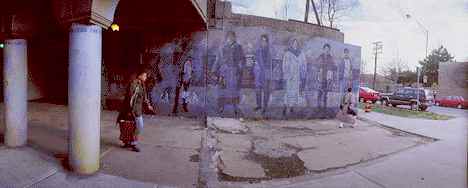
I Welcome Myself to a New Place
(1988)
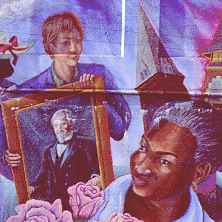 Conceived to help bond the primarily African-American Roseland
district and its mostly white neighbor Pullman, this 7,200-square-foot mural
takes its name from a line of poetry written by one of Gude's former
high-school students: "I welcome myself to a new place where all the people
can join on in together."
Conceived to help bond the primarily African-American Roseland
district and its mostly white neighbor Pullman, this 7,200-square-foot mural
takes its name from a line of poetry written by one of Gude's former
high-school students: "I welcome myself to a new place where all the people
can join on in together."
Gude and husband Jon Pounds -- Pullman residents -- teamed with artist Marcus
Akinlana and went door-to-door asking for support. Over nine months, more
than 100 people from both neighborhoods helped to raise funds and to create
the mural, located at 113th Street and Cottage Grove under the Metra
railroad tracks that divide Roseland from Pullman. The mural features
historical figures from both communities; African, European, and
Native-American craft patterns; Dutch farmers; and a contemporary black
family.
Several years after finishing the project, while working on the Hyde Park
mural (above), Gude was approached by a young man from Roseland, who,
unaware of her involvement, related the making of the Roseland-Pullman
mural. "That was such a great gift, to have that story come back to me," she
says. "Instead of this child growing up with only an image of neighborhood
segregation, he has a very powerful image of the possibility of cross-racial
cooperation."
A Place in Time
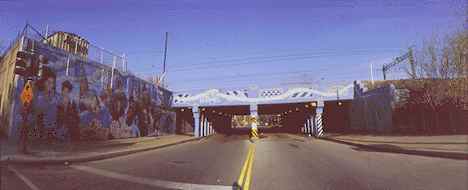
Where We Come From... Where We're Going
(1992)
In the spring of 1991, Gude stood outside a Hyde Park train station,
tape recorder in hand, asking each passerby, "Where are you coming from?
Where are you going?" Answers came on literal, spiritual, and emotional
levels as people discussed their families, jobs, cultures, hopes, and fears.
Gude, the lead artist, chose the most telling responses and, assisted by
Rolf Mueller, painted those comments and portraits of many of the speakers
on the underpass.
"This mural is meant to ask, Is a neighborhood a community just because the
people are in the same geographic space?" Gude says. She doesn't try to
answer, letting the words speak for themselves. Text has become increasingly
prominent in Gude's art as she attempts to capture "the poetry of the
streets," or a neighborhood's oral history. With this piece, she not only
set out to reveal a bit of Hyde Park's essence, but also to evoke the city
as a whole. Gude points out the muted "Chicago" colors-unusual for a
mural-adding, "It's also probably one of the few murals you'll ever see
where people are wearing coats."
Fresh Air
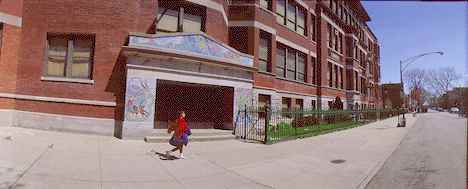
The Lowell Centennial Mosaics
(1994)
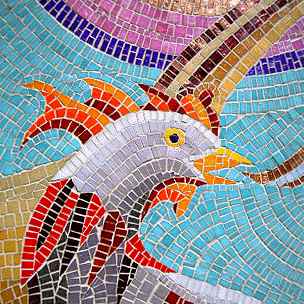 Made of Venetian glass tesserae (tiles), these mosaics frame two
entryways of James Russell Lowell School, marking the school's 1994
centennial. Two of them cover ground-level windows that were bricked over
for security reasons, a not-uncommon practice in Chicago's public schools.
Made of Venetian glass tesserae (tiles), these mosaics frame two
entryways of James Russell Lowell School, marking the school's 1994
centennial. Two of them cover ground-level windows that were bricked over
for security reasons, a not-uncommon practice in Chicago's public schools.
"We 'opened' the windows," says Gude, referring also to Beatriz Santiago
Muñoz, Juan Chavez, and members of Youth Service Project. She cites a
European tradition of reinventing a space in response to contemporary times,
rather than the American way in which old buildings are either destroyed, or
deemed historic and left untouched. "It's not defacing a historic building,"
she adds, "It's adding something at a level of complexity and beauty that
really is architectural."
In recent years, Gude notes, Chicago Public Art Group has completed several
similar projects with Chicago schools, in conjunction with school reform:
"Physically working with the architecture becomes part of what it means to
have local control of schools... what's going to be taught in the school,
what's going to be imagined in the school, what that school means to the
community."
Life Lessons
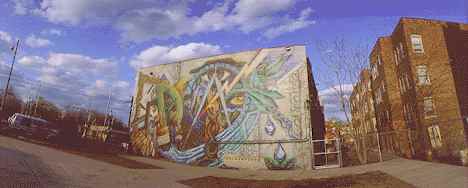
Where There Is Discord, Harmony: The Power of Art
(1991)
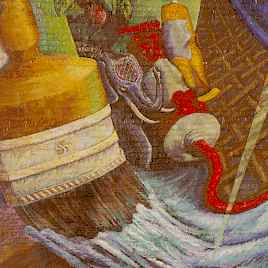 Painted on the west wall of One Artist Row-a building of art studios
and businesses on East 71st Street-this was the third in a series of murals
created by the South Shore Arts Enterprise. After a brainstorming committee
decided the piece should highlight the building's purpose and reflect the
importance of art in all aspects of culture, lead artists Gude and Marcus
Akinlana, assistant Ivan Watkins, and 11 local teenage apprentices set to
work. Days began with set-up time, followed by a brief meditation,
discussion, or lesson, and a harambee-an African-inspired "coming together"
cheer.
Painted on the west wall of One Artist Row-a building of art studios
and businesses on East 71st Street-this was the third in a series of murals
created by the South Shore Arts Enterprise. After a brainstorming committee
decided the piece should highlight the building's purpose and reflect the
importance of art in all aspects of culture, lead artists Gude and Marcus
Akinlana, assistant Ivan Watkins, and 11 local teenage apprentices set to
work. Days began with set-up time, followed by a brief meditation,
discussion, or lesson, and a harambee-an African-inspired "coming together"
cheer.
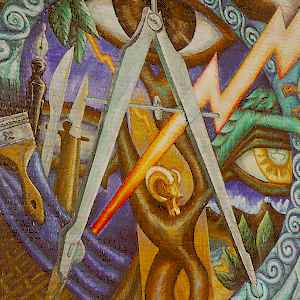 The spiral dominating the wall symbolizes the cycle of death and rebirth,
while the tree represents life, knowledge, and creativity.
Artists'
tools mingle with artistic products and spiritual and cultural symbols from
Africa, Europe, Asia, and Mexico. The frames allude to the social conditions
in which art is made and seen. Of the final product, Gude wrote, the mural,
"while following the mural tradition of incorporating pattern and symbols
from the cultures of neighborhood residents, eschewed the tradition of using
human figures and an obvious narrative structure."
The spiral dominating the wall symbolizes the cycle of death and rebirth,
while the tree represents life, knowledge, and creativity.
Artists'
tools mingle with artistic products and spiritual and cultural symbols from
Africa, Europe, Asia, and Mexico. The frames allude to the social conditions
in which art is made and seen. Of the final product, Gude wrote, the mural,
"while following the mural tradition of incorporating pattern and symbols
from the cultures of neighborhood residents, eschewed the tradition of using
human figures and an obvious narrative structure."
[Home]
[Programs]
[Gallery]
[News]
|

